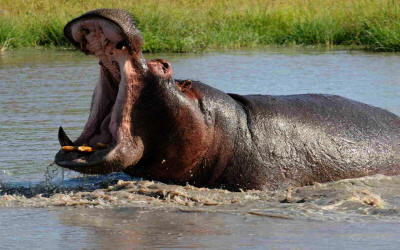Hippos are the third-largest living land mammal, after elephants and white rhinos. Despite their large and bulky appearance, they have adaptations to their semi-aquatic environments allowing them to move swiftly on both water and land. Their feet have four-webbed toes that splay out to distribute weight evenly and therefore adequately support them on land, and their short legs provide powerful propulsion through the water. They have skin tones of purple-gray or slate color, with brownish-pink coloring around their eyes and ears. They have very thick skin that is virtually hairless except for the thick bristle-like hair on their heads and tails. The outer layers of skin are quite thin, making them prone to wounds from fighting. Their flat, paddle-like tail is used to spread excrement, which marks territory borders and indicates status of an individual. Their powerful jaws are capable of opening up to 150 degrees revealing their enormous incisors.
Two hippo species are found in Africa. The common hippo (also known as the large hippo), found in East Africa, occurs south of the Sahara. Ethiopian Hippos can be spotted on Lake Tana, Lake Ziway, Lake Langano, Awash River and in National Parks.

